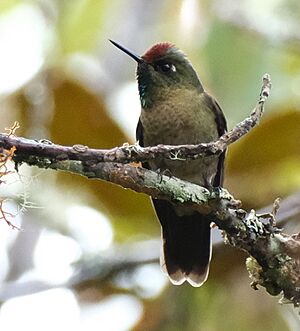Rufous-capped thornbill facts for kids
Quick facts for kids Rufous-capped thornbill |
|
|---|---|
 |
|
| Conservation status | |
| Scientific classification | |
| Genus: |
Chalcostigma
|
| Species: |
ruficeps
|
 |
|
The rufous-capped thornbill (Chalcostigma ruficeps) is a small, colorful hummingbird. It belongs to a group of hummingbirds called "coquettes." You can find this bird in the mountains of Bolivia, Ecuador, and Peru.
Contents
About Its Name
The rufous-capped thornbill is a type of hummingbird. Scientists sometimes discuss how it fits into the hummingbird family tree. For example, some think it might be grouped with other birds in the Oxypogon genus. However, for now, it is the only species in its own group, meaning it is "monotypic."
What It Looks Like
The rufous-capped thornbill is about 10.5 centimeters (4.1 inches) long. It weighs between 3.3 and 3.9 grams (about 0.12 to 0.14 ounces). Both male and female birds have a very short, black beak.
Male Birds
Male rufous-capped thornbills have a bright, reddish-brown cap on their head. The rest of their upper body is a shiny bottle green. They have a thin, emerald green patch on their throat, called a gorget. This green patch has a border that changes colors, including shades of yellow. Their belly is reddish-brown with green spots, especially on their sides. Their tail is a dull olive green.
Female Birds
Female rufous-capped thornbills have a bottle green color on their upper body, including their head. Their throat and chest are an orange-brown color with small olive green dots. The outer feathers of their tail have pale tips.
Where It Lives
The rufous-capped thornbill lives on the eastern side of the Andes mountains. You can find it from southeastern Ecuador, through Peru, and into Bolivia. It has also been seen sometimes in Colombia.
This bird likes to live in different kinds of mountain areas. These include humid forests, cloud forests, and areas where trees are growing back. It usually lives at heights between 1,400 and 3,500 meters (about 4,600 to 11,500 feet) above sea level. It is most common around 2,500 meters (about 8,200 feet).
How It Behaves
Movement
The rufous-capped thornbill might move to different heights in the mountains depending on the season.
Feeding
This hummingbird mainly eats nectar from various flowers. It especially likes flowers from the Melastomataceae family. It usually clings to the flower to drink nectar, but sometimes it hovers. It sometimes "robs" nectar by making a hole at the bottom of a flower. It also feeds at holes made by other birds called flowerpiercers.
Rufous-capped thornbills look for food from low to medium heights in the plants. Male birds will protect their feeding areas. They also eat insects, but scientists are not sure exactly how they catch them.
Reproduction
The breeding season for the rufous-capped thornbill is from December to March in Bolivia. In Peru, it might be from July to October. The female bird lays two white eggs and takes care of them by herself. Not much else is known about how they raise their young.
Vocalization
The sounds the rufous-capped thornbill makes are not fully understood. However, they do make a short, dry double rattling sound, like "trr-trr." They also make a rising and falling twittering sound, like "t-tr-tr-tsee-tseee-tititrrr."
Status
The IUCN (International Union for Conservation of Nature) says the rufous-capped thornbill is a species of "Least Concern." This means it is not currently in danger of disappearing. It lives in a large area, but its total population size is unknown. Scientists believe its numbers might be decreasing. Even though it's generally not a common bird, it seems to be able to live in areas that have been changed a bit by humans.


